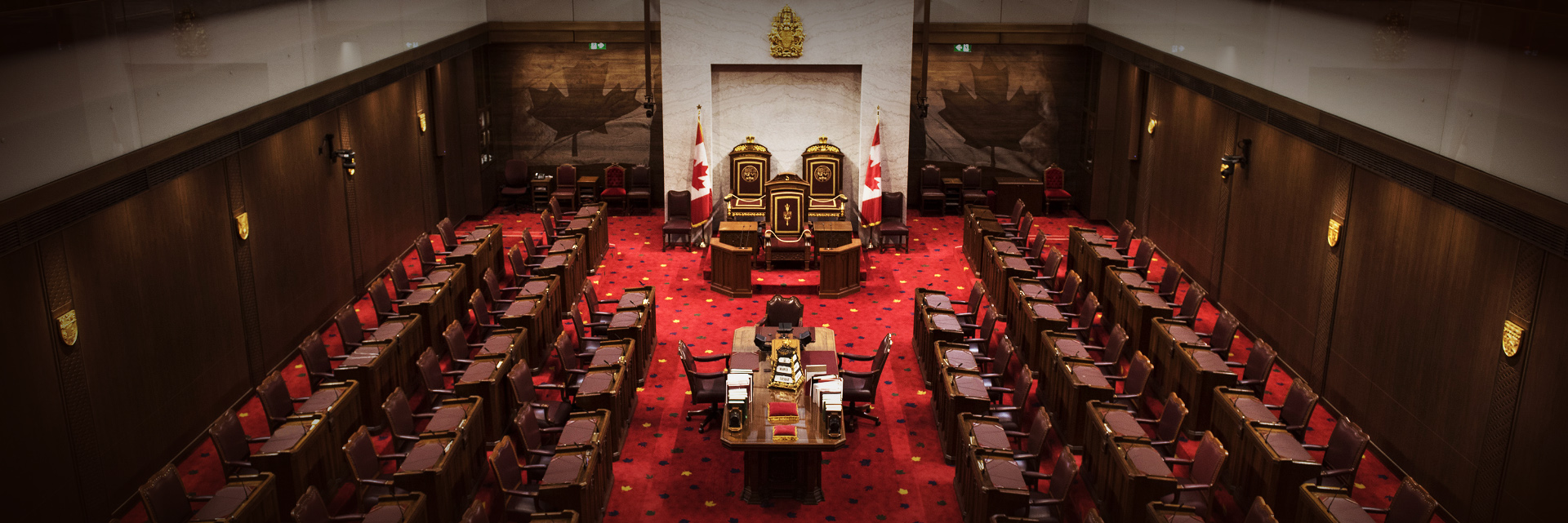
The Senate
Motion to Urge the Government to Raise Awareness of the Magnitude of Modern Day Slavery and Human Trafficking and to Designate February 22 of Each Year as National Human Trafficking Awareness Day--Debate Adjourned
March 18, 2019
Pursuant to notice of February 20, 2019, moved:
That the Senate call on the government to raise awareness of the magnitude of modern day slavery in Canada and abroad and to take steps to combat human trafficking; and
That the Senate also urge the government to designate the 22nd day of February each year as National Human Trafficking Awareness Day, to coincide with the anniversary of the unanimous declaration of the House of Commons on February 22, 2007, to condemn all forms of human trafficking and slavery.
He said: Honourable senators, this motion is being moved today on behalf of the All-Party Parliamentary Group to End Modern Slavery and Human Trafficking. A similar motion was moved recently in the other place.
The group was launched in April of last year and its members include representation from the Liberal, Conservative, NDP and Green parties in the other place, as well as the Independent Senators Group here in this chamber.
The group’s activities are also supported by a partnership with the Allard School of Law’s International Justice and Human Rights Clinic at the University of British Columbia.
Our priorities are as follows: to ensure that the Government of Canada does all it can to prevent and protect civilian populations from modern slavery, to increase prosecution of traffickers and to build partnerships with various organizations; to increase the flow of information and analysis to parliamentarians about modern slavery; to promote understanding of the importance of long-term approaches to the prevention of slavery; and to engage in communications and collaboration with like-minded bodies in civil society and other parliaments.
Honourable colleagues, we seek to cultivate a Canada free from exploitation and modern slavery; equally, we recognize the immense value in building strong partnerships to combat this insidious scourge on our society. Our group, therefore, seeks your support of this motion so that we may designate the 22nd day of February each year as National Human Trafficking Awareness Day.
Wela’lioq. Thank you.
Honourable senators, this evening I rise to speak in support of the motion calling for February 22 to be designated National Human Trafficking Awareness Day, with appreciation for this initiative to Senator Christmas and the All-Party Parliamentary Group to End Modern Slavery and Human Trafficking, of which I am proud to be a founding member.
Human trafficking is, without a doubt, a critical issue. We need to address this phenomenon around the world, but also here in Canada. We need to raise awareness about situations of vulnerability and exploitation facing some people in our own communities. Sexual exploitation and human trafficking are not separate phenomena, and Canada is certainly not immune to them.
The trafficking in children, the business of adults selling access to other adults of children’s bodies, is well documented in Winnipeg, where I reside. My colleague, Diane Redsky, the CEO of one of the largest Aboriginal-led organizations in Canada, known as Ma Mawi, has testified on a number of occasions on rescuing Indigenous children from traffickers. Winnipeg police have repeatedly confirmed that the majority of these trafficked children of are Indigenous origin.
In 2018, the United Nations Office on Drugs and Crime released a global report on trafficking in persons, noting that between 2011 and 2016, there was nearly a 40 per cent increase in detected human trafficking victims worldwide. Furthermore, an important finding that emerged from the global report was that countries that enhanced their anti-trafficking actions reported higher numbers of trafficking victims. This is a clear indication that to make evidence-based decisions on countering human trafficking, we must have credible evidence on the extent of human trafficking. We must do this in order to go beyond commitment to actually implementing stronger anti-trafficking strategies.
According to Statistics Canada, instances of human trafficking in Canada have been on the rise since 2010. Of these instances, more than half involve another offence. Typically, this other offence is prostitution. Of the 865 human trafficking victims from 2009 to 2016, 95 per cent were women and girls; 72 per cent of them were under 25 years of age; and 26 per cent of them were under 18 years of age, which means they are children.
Following her visit to Canada in April 2018, the UN Special Rapporteur on violence against women, its causes and consequences, stated that trafficking requires serious attention in Canada. She noted there is a general lack of data on human trafficking in Canada, including data on trafficking for the purposes of sexual exploitation. The Special Rapporteur also noted that Indigenous women and girls are particularly vulnerable to becoming victims of human trafficking.
The concern for Indigenous women and girls was also highlighted in Senator Sinclair’s final report on the Thunder Bay Police Services board investigation, released a short while ago. As a major hub for transportation in Ontario, and as a port city on Lake Superior, Thunder Bay continues to be a site of human trafficking. The report confirmed that the average age of Indigenous girls trafficked for the purposes of sexual exploitation is 14 years old. Some of these victims are as young as 10.
Honourable senators, these are not abstract numbers. They represent human beings whose lives are treated by us and our society to be, in essence, disposable if we do not take action.
Designating February 22 as National Human Trafficking Awareness Day is a step we must take. In doing so, we will create a recurring mechanism to remind all Canadians and ourselves as parliamentarians that we cannot — we must not — turn away from the scourge of human trafficking in Canada and the world.
Thank you. Meegwetch.
Senator Martin, on debate?
No, Your Honour. Actually, I just wanted to say that this is a very important motion. I want to thank Senator Christmas and Senator McPhedran for her words. I will take adjournment —
Sorry, Senator Martin. Before you take adjournment, I believe there’s another senator who wishes to speak.
I’m sorry. I thought there were only two.
I see that it is late and will try to be brief.
I rise to support Motion No. 439 to urge the government to raise awareness of the magnitude of modern day slavery and human trafficking.
It is hard to fathom that, in 2019, we still tolerate forms of slavery on our planet. Slavery is often mistakenly perceived as a phenomenon of the past that no longer exists. The large-scale slavery of Africans remains with us and has become a literary theme.
In Véronique Olmi’s poignant book Bakhita, which is based on a true story, the heroine is born in Darfur in 1869. She is taken to Sudan, where slave trafficking is rampant. She is seven years old when her two abductors sell her to masters who beat and insult their slaves. I will read an excerpt.
The slave trader took her chin in his hands, forcing her to open her mouth and show her teeth. He threw a stick, expecting her to run to retrieve it and then bring it back. She did not understand at first. She did not run to get it. He slapped her and started over. She ran. The man spit when she fell. Her legs could no longer carry her...She did not understand what was expected of her. She was frantic. She did not know what they wanted. They inspected her. Everywhere. It hurt...
This passage carefully describes the violence that far too many people experience daily. In the meantime, forms of slavery may have changed a bit, but the violence still remains. Today, what we call modern slavery includes forced labour, sex trafficking, and forced marriages. As my colleague said, these phenomena affect girls in particular and women across the globe who are still victims of inequality and discrimination.
An estimated 4.8 million, almost exclusively girls and women, are victims of forced sexual exploitation, and 15 million people, again mostly girls, have been forced to marry. A vast majority of these forms of exploitation occur far away from here in countries where young girls are married or sold to much older men. They experience early pregnancies that result in horrible complications such as fistulas. Canada is not immune to this either. Barely a month ago, 43 Mexicans who were reduced to slavery were freed by police in the Barrie region in Ontario. These men were forced by their traffickers to work as cleaners for $50 a month.
At a time when the debate over prostitution is often reduced to a question of individual choices and women’s freedom, it is vital to remember that the line between so-called sex work and sexual exploitation is not always clear. I participated in researching and writing a paper entitled Prostitution: Time to Take Action that was published by Quebec’s Conseil du statut de la femme. I’d like to read you an excerpt from the testimony of a 25-year-old Montreal woman named Marie, who fell into the clutches of a violent pimp who forced her to hand over all her earnings, isolated her from her family and controlled all her movements. That’s a form of slavery too.
This is what she had to say.
He was always watching. I wasn’t allowed to turn my head, to talk to who I wanted. I danced every night. I was raped three times a week at the bar where I danced. I had to call his cell phone every 30 minutes to tell him what I had been doing, how many clients and dancers there were in the room. He calculated in his head how much money I had to bring back at the end of the night. If I didn’t bring back enough, I’d be beaten. One day, he broke two of my teeth. He liked to strangle me until I lost consciousness.
It is difficult to imagine that the trafficking of women and girls actually exists in Canada. What is more, it disproportionately affects Indigenous women. In Quebec, television series and the arrest of pimps brought to light this clandestine phenomenon in which young girls end up under the control of street gangs, where they are conditioned to their new reality through repeated rape, locked up and, most importantly, taken far from home to other provinces such as Ontario and Alberta so that the gangs can make as much money as they can from them by passing them from client to client. It is difficult to determine the scope of this phenomenon, and members of the Quebec National Assembly are proposing to conduct a parliamentary inquiry to take stock of the situation.
Laws are essential. Unfortunately, one of the tools to better prevent exploitation and human trafficking, Bill C-38, which amends the Criminal Code, has been stuck at first reading stage in the House of Commons for two years now, and I am worried that we will not be able to examine it here in the Senate before the election. It isn’t too late for the new Minister of Justice to get it back on track. Otherwise, it will be a missed opportunity. Thank you.

